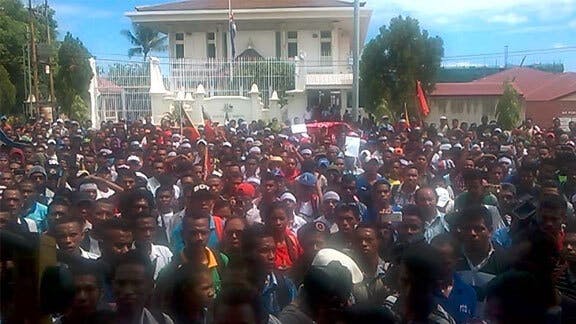Big Protest confronts Australian Embassy in Dili

A large and angry demonstration was held outside the Australian embassy in Dili on 23 February, against the Australian government’s refusal to negotiate a permanent international border with East Timor.
The protest – organised by the coalition Movement Against the Occupation of the Timor Sea (MKOTT) – included dozens of organised contingents of students, young people, civil society groups and veterans of the national liberation struggle. “Timor Leste, viva! Australia, abaixo!” (“Long Live East Timor! Down with Australia!”) – was one popular chant.
The embassy had been subject to a smaller protest in 2013 and a graffiti protest in 2014 after it was revealed that the Australian Secret Intelligence Service (ASIS) spied on the Timorese government during negotiations over a temporary resource sharing arrangement. This latest protest indicates a dramatic escalation.
Tama Laka Aquita, vice president of the Socialist Party of Timor (PST), told Red Flag that another protest will take place on 22-23 March. This will coincide with protests in Melbourne, Sydney, Adelaide and New York in the same week. PST president Avelino Coelho has already been on television talking up the issue.
All Timorese political parties agree that resolving the border dispute is a national priority. That has been reflected in a string of recent media statements by senior politicians calling Australian spying “a criminal act”, to quote Xanana Gusmao the historic leader of the Timorese resistance, and calling for an immediate re-start to negotiations to finalise the border.
The Timorese parliament has appointed a Council for Final Delimitation of Maritime Boundaries, which includes all former presidents, prime ministers and speakers of the parliament. Gusmao has been elected chief negotiator.
Australia’s present violation of Timorese sovereignty denies Timor the resources it badly needs for even basic national development. Many Timorese still lack access to electricity or safe water. Young people with university education are often lured to foreign NGOs or AID organisations that can pay higher wages than teachers receive at the National University of Timor Leste.
There are large gas reserves beneath the Timor Sea – particularly the enormous, undeveloped Greater Sunrise gas field, which is almost entirely on the Timorese side of the halfway line. In net terms, East Timor is actually the largest foreign aid contributor to Australia – if we count revenues taken by the Australian Treasury from gas already extracted from smaller, already developed fields on Timor’s side of the halfway line.
Australia’s aggression, for a time, seemed to be successful. Just prior to Timor gaining independence in 2002, foreign minister Alexander Downer reportedly told the UN transitional administrator of East Timor, Sergio Vieira de Mello, “Australia could bring meltdown to East Timor if it so chose” – i.e. by withdrawing foreign aid while the country was still waiting for gas revenues to come on line. In March 2002, Downer announced Australia’s withdrawal from the maritime boundary jurisdiction of the International Court of Justice.
The following month, Canberra was able to obtain a signature from then Timorese prime minister Mari Alkatiri, for the highly unfair, temporary, Timor Sea Treaty. The TST encountered immediate opposition and was never ratified by the Timorese parliament.
However, in 2006 then foreign minister Ramos Horta signed another highly unfair agreement with Australia. The new agreement – CMATS (Certain Maritime Arrangements in the Timor Sea) – gave a partial concession to Timor by allowing it 50 percent, up from 18 percent, of the revenues from Greater Sunrise. However, it completely excluded Timor’s government and oil company from participation in the development and required Timor to postpone all negotiations for a permanent settlement of the boundary for 50 years.
Now even Horta is on record calling for Australia to re-start negotiations for a permanent settlement, as is Alkatiri. The new atmosphere of protest – which extends from the streets to the parliament – if it can be sustained and supported by a lively campaign in Australia, might prove correct what former Australian ambassador to Indonesia Richard Woolcott cabled to Canberra in 1975.
Woolcott argued for Australia to support the Indonesian invasion of the country in 1975 – which led to a quarter-century occupation and the death of 200,000 people. He thought that “closing the present gap in the agreed sea border” (i.e. finalising a border closer to Timor than Australia) “could be much more readily negotiated with Indonesia … than with Portugal or independent Portuguese Timor”.
Indeed, the original Timor Gap Treaty that the Australian Labor government famously signed with the Indonesian military dictatorship in 1989 was far worse than the present CMATS. But even CMATS is no longer accepted by independent East Timor. Unfortunately for Malcolm Turnbull and his ilk, there is no longer a military dictatorship in Timor than can put down protests against the Australian embassy.
It seems safe to assume that embassy staff, DFAT and the Turnbull government must be monitoring the growing movement with increasing alarm. Working people in Australia should greet it not only with joy but with active support. The most meaningful solidarity we can give is by building our own movement to support East Timor’s democratic and sovereign right to complete its national self-determination. Viva Timor Leste!